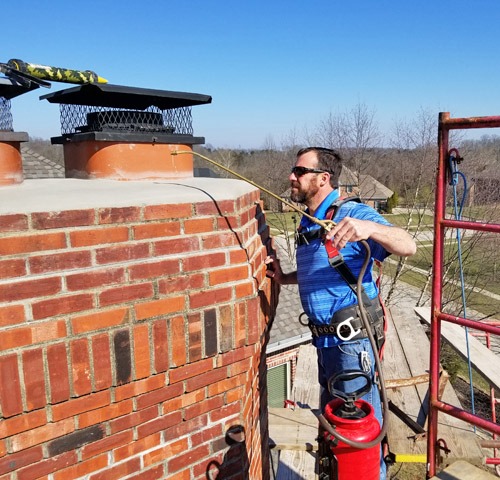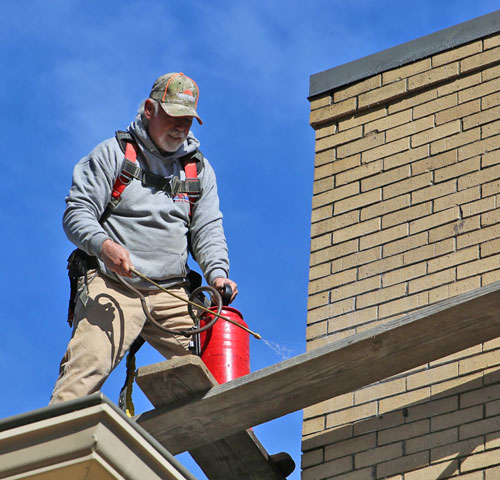Louisville KY Chimney Waterproofing Prevents Leaky Chimneys
 Chimneys are extremely vulnerable to moisture damage, which is why Louisville Chimney Sweep & Repair, LLC, recommends using water repellent for chimney waterproofing as a preventative measure. Common brick is porous and can absorb moisture like a sponge. Even if stone is used for chimney masonry, water can cause destruction. The mortar that binds the stones deteriorates and allows water to infiltrate the structure. During freezing and thawing cycles, the moisture expands and contracts, which can slowly cause deterioration and corrosion. In the case of bricks, the moisture inside results in spalling, which means the exterior face of the brick flakes and pops off. Moisture in the chimney can also cause efflorescence. All of these issues need to be addressed as soon as possible. Otherwise, repair costs get higher and structural failure will eventually occur. Any problems that exist with the chimney must be repaired before adding water repellent for chimney waterproofing.
Chimneys are extremely vulnerable to moisture damage, which is why Louisville Chimney Sweep & Repair, LLC, recommends using water repellent for chimney waterproofing as a preventative measure. Common brick is porous and can absorb moisture like a sponge. Even if stone is used for chimney masonry, water can cause destruction. The mortar that binds the stones deteriorates and allows water to infiltrate the structure. During freezing and thawing cycles, the moisture expands and contracts, which can slowly cause deterioration and corrosion. In the case of bricks, the moisture inside results in spalling, which means the exterior face of the brick flakes and pops off. Moisture in the chimney can also cause efflorescence. All of these issues need to be addressed as soon as possible. Otherwise, repair costs get higher and structural failure will eventually occur. Any problems that exist with the chimney must be repaired before adding water repellent for chimney waterproofing.
What is efflorescence?
If you have stains on your exterior chimney masonry, it means efflorescence has occurred. The staining could look fuzzy, fluffy, or like a crystallized powder. The color is usually white but can also have a range of hues, including different shades of green.
The only time efflorescence appears is if the following three conditions exist:
- There must be soluble salts in the masonry (salt particles are not present in all masonry);
- Enough moisture must enter the masonry to create a soluble solution with the salts; and
- The salt solution is able to move through the masonry, where it ultimately evaporates and appears as staining on the exterior of the chimney.
The color of staining caused by efflorescence is determined by the minerals in the masonry. For instance, magnesium causes greenish stains. The presence of efflorescence is a clear indication that moisture has infiltrated your chimney system and repair is needed.
Types of Chimney Damage Caused by Moisture
Water can get into your chimney system in a number of different ways. If you don’t have a chimney cap, rain, sleet, and snow can pour directly into your chimney. If your chimney crown develops cracks, water enters the chimney through the cracks. If the chimney flashing isn’t properly installed or if it deteriorates, it can cause leaks. As mentioned before, when mortar begins to deteriorate, it allows moisture into the structure. The following are some types of damage caused by moisture in a chimney:
- Water-stained ceiling and walls
- Decayed exterior mortar
- The flue liner has cracks or other signs of deterioration
- Rusted damper assemblies
- Glass doors and other fireplace accessories develop rust
- Rotting adjacent wood and ruined wall coverings
- Tilted or collapsed chimney structure
 Chimney Waterproofing with Water Repellent
Chimney Waterproofing with Water Repellent
If your chimney is in good condition, chimney waterproofing can help to keep it that way. Some excellent waterproofing agents are available that do a great job of keeping moisture out of chimney systems. The formulas we use at Louisville Chimney Sweep & Repair allow the chimney to breathe because the formulas are 100% vapor permeable. By having our professionals apply water repellent on the exterior of your chimney, you are helping to ensure that water will not enter your chimney from the outside.
Contact us at Louisville Chimney Sweep & Repair for chimney waterproofing. Call (502) 410-4019 today.





 Tap to Call Now
Tap to Call Now